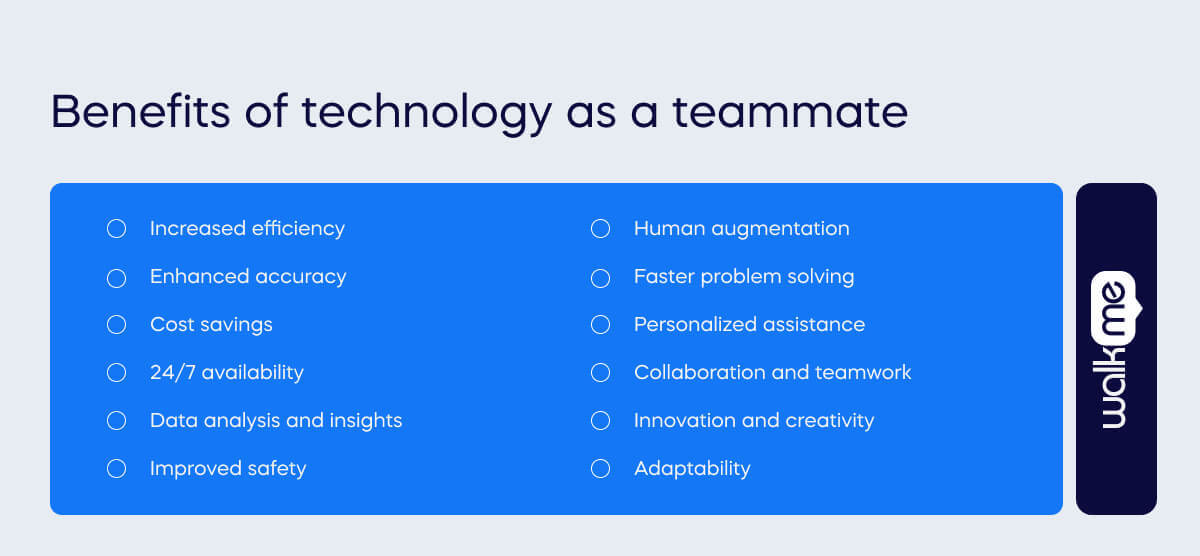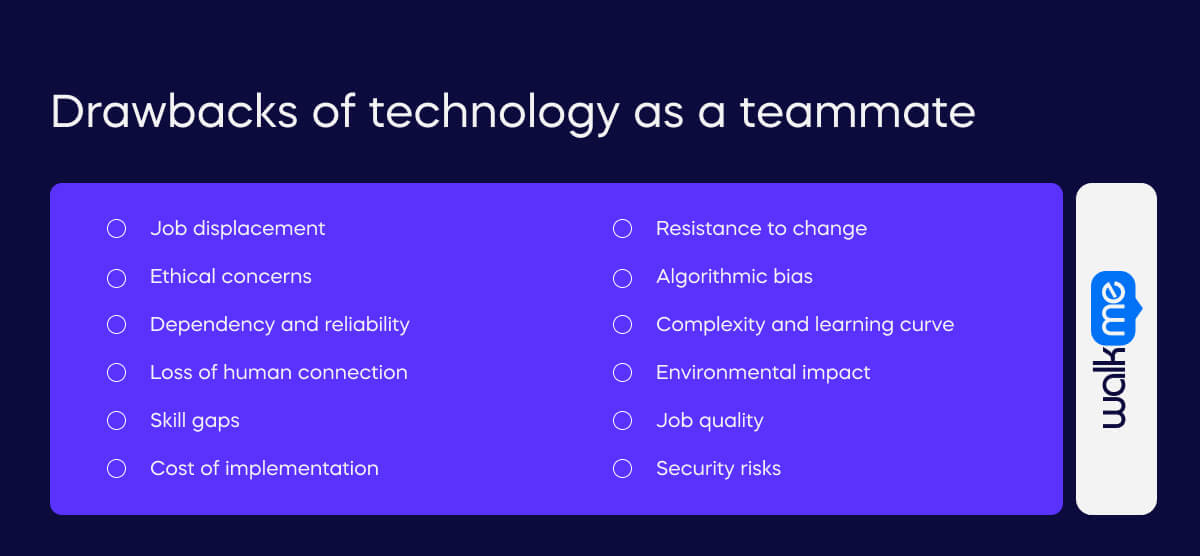What does “Technology as a Teammate” mean?
The concept of “technology as a teammate” refers to the idea that advanced technologies, such as artificial intelligence (AI), robotics, and automation, can work collaboratively with humans in various tasks and activities.

Table of contents
- What does “Technology as a Teammate” mean?
- How technology can be used as a team mate
- Which tasks can technology expedite as a teammate?
- Benefits of technology as a teammate
- Drawbacks of technology as a teammate
- Picking the business areas for using technology as a teammate
- How to roll out technology as a teammate in business
Instead of viewing technology as a tool or a separate entity, this perspective emphasizes integrating technology seamlessly into human workflows to enhance productivity, efficiency, and overall performance.
In a collaborative or teammate framework, technology is designed to complement human skills and capabilities, fill gaps, automate routine tasks, and support decision-making processes.
This approach recognizes the strengths of both humans and technology, with the goal of creating a synergistic partnership that maximizes the advantages of each.
For example, in the workplace, technology as a teammate might involve AI systems assisting employees in data analysis, automating repetitive tasks, or providing insights to aid in decision-making.
In fields like healthcare or manufacturing, robots may work alongside human professionals, handling certain aspects of tasks while humans focus on more complex or nuanced aspects.
The idea is not to replace humans with technology but to leverage technology to augment human capabilities and improve overall performance in various domains.
This concept is particularly relevant as technology continues to advance, and the integration of AI and automation becomes more prevalent in various aspects of our lives and work.
How technology can be used as a team mate

Advancements in technology are revolutionizing our approach to work and collaboration.
From integrating collaborative robots in manufacturing to deploying AI in healthcare and business analytics, explore the diverse ways technology acts as an indispensable teammate.
Collaborative robots (cobots) in manufacturing
Cobots are designed to work alongside human workers in manufacturing environments. They can perform repetitive or physically demanding tasks, such as lifting heavy objects or assembling components, allowing humans to focus on more complex and strategic aspects of production.
AI in healthcare
Artificial intelligence is used in healthcare for tasks like diagnostic imaging analysis. AI algorithms can assist radiologists in interpreting medical images, helping to detect abnormalities more efficiently and accurately.
Virtual assistants and chatbots
Virtual assistants like Siri, Google Assistant, and chatbots on websites use natural language processing to understand and respond to user queries. They assist users in finding information, completing tasks, or navigating through applications.
AI in business analytics
AI is often employed in business analytics to analyze large datasets and provide insights. This can assist human decision-makers in making more informed choices based on patterns and trends identified by the AI system.
Autonomous vehicles
Self-driving cars and drones are examples of technology functioning as teammates in transportation. These vehicles use sensors and AI algorithms to navigate and make decisions, potentially enhancing safety and efficiency.
Exoskeletons in industry
Exoskeletons are wearable robotic devices that can augment human strength and endurance. They find applications in industries where workers need to lift heavy loads, reducing the physical strain on the human body.
Smart assistants for productivity
Smart assistants like Microsoft’s Cortana or Amazon’s Alexa can assist with scheduling, reminders, and other organizational tasks. They can act as virtual teammates, helping users manage their time and tasks more efficiently.
AI in finance for fraud detection
In the financial sector, AI algorithms detect unusual transaction patterns that may indicate fraudulent activity. Human analysts can then investigate and take appropriate actions.
Which tasks can technology expedite as a teammate?
The range of tasks where technology serves as a supportive ally, enhancing efficiency and accuracy, is vast and varied. Its influence in simplifying processes and guiding decisions across different industries is profound and transformative.
Communication
Technology facilitates real-time communication through email, instant messaging, video conferencing, and collaborative platforms, making it easier for team members to stay connected regardless of physical location.
Collaborative editing and document sharing
Cloud-based tools enable teams to collaborate on documents in real-time. Multiple team members can edit, comment, and provide feedback simultaneously, streamlining the document creation and review process.
Project management
Agile project management tools automate task assignment, progress tracking, and deadline management. They enhance team coordination, improve workflow efficiency, and provide visibility into project timelines.
Data analysis and reporting
Technologies like data analytics and business intelligence tools automate the analysis of large datasets, providing valuable insights for decision-making. Reporting tools generate visualizations and summaries for easier understanding.
Automation of repetitive tasks
Robotic Process Automation (RPA) and workflow automation tools can handle routine, repetitive tasks, reducing manual effort and minimizing the risk of errors.
Customer relationship management (CRM)
CRM systems help teams manage customer interactions, track leads, and streamline sales and marketing efforts. Automation features in CRM can improve customer engagement and relationship management.
Employee onboarding and training
Technology simplifies the employee onboarding process through digital documentation, online training modules, and virtual orientation sessions.
Collaborative design and prototyping
Teams involved in design and prototyping benefit from collaborative software tools that allow multiple contributors to work on designs simultaneously, fostering creativity and efficiency.
Virtual meetings and webinars
Virtual meeting platforms facilitate team discussions, presentations, and webinars. These tools eliminate the need for physical presence, making it easier for geographically dispersed teams to collaborate.
Task automation in software development
DevOps practices and automation tools streamline software development processes by automating tasks like code testing, integration, and deployment, leading to faster and more reliable software releases.
Inventory management and supply chain optimization
Technologies like RFID, IoT, and AI optimize inventory management and supply chain processes, helping teams track and manage inventory levels, reduce wastage, and improve overall efficiency.
HR and recruitment processes
HR software automates recruitment processes, employee record-keeping, and performance evaluations. Chatbots and AI can assist in initial candidate screening.
Customer support and chatbots
AI-powered chatbots assist teams in providing efficient customer support by handling routine queries and freeing human agents to focus on more complex issues.
Sales forecasting
AI and machine learning algorithms can analyze historical sales data and market trends to provide accurate sales forecasts, assisting sales teams in planning and strategy.
Cybersecurity monitoring and threat detection
Automated cybersecurity tools continuously monitor networks for potential threats, identify vulnerabilities, and respond to security incidents in real-time.
Benefits of technology as a teammate

Technology as a teammate brings a multitude of benefits, from increased productivity to enhanced creativity. Its role in enabling better decision-making and fostering innovation across various fields illustrates its invaluable contribution to modern work dynamics.
Increased efficiency
Technology can automate routine and repetitive tasks, allowing humans to focus on more complex and creative aspects of their work. This leads to increased overall efficiency and productivity.
Enhanced accuracy
Technologies like AI can perform tasks with a high degree of accuracy and consistency, reducing the likelihood of errors that may occur due to fatigue or human oversight.
Cost savings
Automation and technology can lead to cost savings by streamlining processes, reducing the need for manual labor in certain tasks, and minimizing errors that may result in costly rework.
24/7 availability
Automated systems and technologies can operate around the clock without the need for breaks, contributing to continuous operations and improved service availability.
Data analysis and insights
Technology can analyze large datasets at a speed and scale that would be challenging for humans. This enables the extraction of valuable insights and patterns from data, facilitating better decision-making.
Improved safety
In manufacturing, construction, and healthcare industries, technology can handle dangerous or physically demanding tasks, reducing the risk of accidents and injuries to human workers.
Human augmentation
Technologies like exoskeletons and wearable devices can augment physical abilities, enhancing strength, endurance, and overall well-being in tasks that require physical exertion.
Faster problem solving
AI systems can quickly process vast amounts of information to identify patterns and anomalies. This enables faster problem-solving and decision-making in scenarios where time is critical.
Personalized assistance
Virtual assistants and AI systems can provide personalized assistance, tailoring responses and recommendations based on individual preferences and behaviors.
Collaboration and teamwork
Technology can facilitate collaboration among teams by providing communication tools, project management platforms, and shared digital workspaces, fostering a collaborative work environment.
Innovation and creativity
Technology can catalyze innovation by automating routine tasks and freeing time for humans to focus on creative and strategic thinking.
Adaptability
Technologies can be easily updated and adapted to new tasks and challenges, providing a level of flexibility that can be challenging to achieve with traditional systems.
Drawbacks of technology as a teammate

While technology as a teammate offers numerous advantages, it also presents certain drawbacks. Issues such as dependency, privacy concerns, and the potential for skill displacement are important considerations in this evolving relationship.
Job displacement
Automation and AI have the potential to replace certain jobs, particularly those involving routine and repetitive tasks. This can lead to job displacement for certain workers, necessitating reskilling and adaptation to new roles.
Ethical concerns
The use of technology, especially in AI, raises ethical concerns related to privacy, bias in algorithms, and decision-making. Ensuring that technology operates ethically and aligns with societal values is an ongoing challenge.
Dependency and reliability
Overreliance on technology can become a vulnerability. Technical failures, cybersecurity threats, or system malfunctions can have significant consequences if there’s a lack of contingency plans or manual alternatives.
Loss of human connection
In environments heavily reliant on technology, there may be a loss of personal interaction and human connection. This can impact teamwork, communication, and overall workplace culture.
Skill gaps
As technology evolves, there may be a widening gap between the skills workers possess and the skills demanded by the evolving job market. Addressing this gap through education and training is crucial.
Cost of implementation
Introducing advanced technologies can involve significant upfront costs for research, development, and implementation. Organizations need to carefully weigh these costs against the expected benefits.
Resistance to change
Humans may resist the adoption of new technologies due to fear of job loss, lack of familiarity, or concerns about job security. Overcoming resistance and fostering a positive attitude toward technology adoption is a challenge.
Algorithmic bias
AI systems can inherit biases present in training data, potentially leading to biased outcomes. This can result in unfair treatment or discrimination, especially in areas like hiring, lending, and criminal justice.
Complexity and learning curve
Advanced technologies may be complex and require a significant learning curve. This can pose challenges for individuals who need to adapt quickly to new tools and systems.
Environmental impact
The production and disposal of technology can have environmental consequences. Energy-intensive technologies, if not designed with sustainability in mind, can also contribute to environmental degradation.
Job quality
While some routine tasks may be automated, the quality of certain jobs may decline if the human workforce is primarily engaged in monotonous or unfulfilling tasks.
Security risks
The increased connectivity and reliance on digital systems create new security risks. Cybersecurity threats, including hacking and data breaches, can compromise sensitive information and disrupt operations.
Picking the business areas for using technology as a teammate
The decision to implement technology as a teammate in business requires careful consideration of various areas. Factors like the nature of tasks, the potential for automation, and the alignment with business goals are crucial in making informed choices.
Conduct a comprehensive business analysis
Start by conducting a comprehensive analysis of your business processes. Identify areas where efficiency can be improved, repetitive tasks can be automated, and where the integration of technology can have a significant positive impact.
Assess organizational goals
Align the selection of technology with the overarching goals of your organization. Consider how technology can contribute to achieving strategic objectives, improving competitiveness, and addressing key challenges.
Engage stakeholders
Involve key stakeholders from various departments in the decision-making process. Gather input from managers, team members, IT professionals, and other relevant parties to comprehensively understand needs and challenges.
Prioritize pain points and bottlenecks
Identify pain points and bottlenecks in your current workflows. Technology can often bring the most immediate and impactful improvements in these areas. Prioritize solutions that directly address these challenges.
Evaluate customer and employee experience
Assess areas that directly impact customer experience and employee satisfaction. Technology can be applied to enhance customer interactions, streamline communication, and improve overall employee well-being and productivity.
Consider industry best practices
Stay informed about industry best practices and technological trends. Benchmark your organization against industry leaders and identify opportunities to adopt technologies that have proven successful in similar contexts.
Evaluate regulatory and compliance needs
Consider areas where technology can assist in maintaining compliance with industry regulations and standards. This is particularly important in industries with strict regulatory requirements.
Look for quick wins
Identify areas where technology can deliver quick wins. Starting with smaller, achievable projects allows you to demonstrate the value of technology as a teammate and build momentum for broader adoption.
Assess scalability
Consider the scalability of technology solutions. Choose areas where the technology can easily scale to accommodate future growth and evolving business needs.
Explore collaboration opportunities
Look for opportunities to enhance collaboration within and across teams. Technologies that facilitate communication, file sharing, and collaborative workspaces can significantly improve teamwork and productivity.
Evaluate data-driven opportunities
Assess areas where leveraging data can provide valuable insights. This may include implementing business intelligence tools, analytics platforms, or customer relationship management (CRM) systems.
Assess customer-facing processes
Examine customer-facing processes to identify opportunities for improvement. Technology can enhance customer service, support, and engagement, leading to increased customer satisfaction and loyalty.
Consider emerging technologies
Stay abreast of emerging technologies such as artificial intelligence, machine learning, blockchain, and the Internet of Things. Explore how these technologies can be applied to innovate and improve business processes.
Evaluate employee training and development
Assess areas related to employee training, development, and onboarding. Technology can be utilized to create more efficient training programs, track employee progress, and foster continuous learning.
Review financial and resource constraints
Consider the financial and resource constraints of your organization. Choose technology solutions that align with your budget and resource availability, ensuring a realistic and sustainable implementation.
How to roll out technology as a teammate in business
The process of introducing technology as a teammate in business involves strategic planning and thoughtful execution. Key steps include assessing organizational needs, training staff, and ensuring seamless integration with existing workflows.
Assess organizational needs and goals
Conduct a thorough assessment of your organization’s needs and goals. Identify areas where technology can enhance efficiency, collaboration, and overall productivity. Ensure that the chosen technology aligns with the strategic objectives of the organization.
Involve stakeholders
Involve key stakeholders in decision-making, including CIOs, team members, IT managers, and professionals. Solicit their input, address concerns, and consider their perspectives to ensure a more inclusive and successful implementation.
Select appropriate technology
Choose technology solutions that align with the identified needs and goals. Consider factors such as scalability, integration with existing systems, user-friendliness, and the potential for future growth.
Provide comprehensive training
Develop a comprehensive training program to ensure that all team members are proficient in using the new technology. Training should cover both the technical aspects and practical applications in the context of their roles.
Create a pilot program
Implement the technology on a smaller scale as a pilot program. This allows for testing in a controlled environment, gathering feedback, and addressing any issues before full-scale deployment.
Communicate clearly and regularly
Communicate the implementation plan clearly and regularly to all stakeholders. Clearly articulate the benefits of the new technology and how it aligns with organizational goals. Address any concerns and provide updates throughout the process.
Address data security and privacy
Prioritize data security and privacy considerations. Implement robust security measures to protect sensitive information and communicate these measures to reassure team members about the safety of their data.
Encourage user adoption
Foster a culture of user adoption by highlighting the positive impact of the technology on individual and team performance. Encourage team members to explore and embrace the new tools by emphasizing how it simplifies their work.
Provide ongoing support
Offer continuous support, including access to helpdesk services, FAQs, and user guides. Address issues promptly and provide additional training if needed. Ongoing support is crucial for sustained user confidence and engagement.
Gather feedback and iterate
Collect feedback from users throughout the implementation and after full deployment. Use this feedback to identify areas for improvement, address concerns, and make necessary adjustments. Iterate on the implementation based on real-world usage and experiences.
Monitor and evaluate performance
Implement monitoring tools to track the performance and impact of the technology. Evaluate key performance indicators (KPIs) to measure the success of the implementation against the predefined goals.
Scale up gradually
If the pilot program succeeds, gradually scale up the implementation across the organization. Monitor the scaling process closely, ensuring that the technology integrates seamlessly into various teams and workflows.
Stay agile and adaptive
Technology is dynamic, so stay agile and adaptive. Be open to incorporating updates, new features, and emerging technologies to keep the workplace technology ecosystem current and aligned with evolving organizational needs.